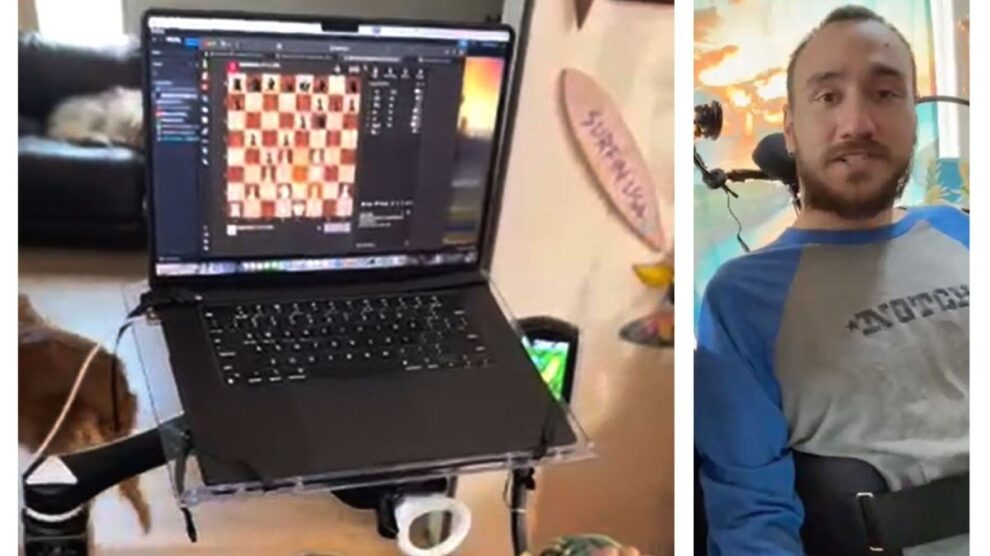In a stunning display of cutting-edge technology melding with the depths of human potential, a patient implanted with Neuralink’s brain-computer interface (BCI) device has achieved the once unfathomable – playing chess using only their mind.
Yes, you read that correctly. While the idea of mentally controlling computers has been a science fiction trope for decades, Neuralink has made it a reality. And in an exclusive demonstration witnessed by a small group that included scientists, chess grandmasters, and myself, the first patient implanted with Neuralink’s pioneering neural device did just that – directly interfacing their brain with a computer to engage in a game of chess against a human opponent.
The patient, whose identity remains confidential for privacy reasons, suffers from a form of paralysis that has robbed them of the ability to physically interact with a chessboard or input device. However, thanks to the revolutionary brain implant developed by Elon Musk’s neurotechnology startup Neuralink, they can now harness their still-active neurological processes to wirelessly transmit precise thoughts and intentions directly to a nearby computer.
In this instance, those thoughts were instructions to maneuver the chess pieces in defiance of their bodily limitations. Make no mistake – this was no simple parlor trick or gimmicky demo. This was an intense back-and-forth chess match between two skilled players, one fully able-bodied and executing traditional physical movements, the other paralyzed yet internally visualizing each meticulous stratagem that would manifest as methodical animations on the virtual chessboard.
So how exactly does Neuralink’s implant enable this unprecedented mind-to-machine connection? And what does this breakthrough mean for the future of BCIs, both for those with disabilities and beyond? Allow me to explain further, but first, let’s dive into some key details around this historic chess match that has captured imaginations worldwide.
What is Neuralink and How Does Its Brain Implant Work?
Neuralink is a neurotechnology company founded in 2016 by Elon Musk and others with the ambitious mission of developing ultra-high bandwidth brain-machine interfaces. These implantable devices are composed of extremely thin polymer threads containing electrodes that can detect and transmit neuronal spikes, essentially the electrical impulses generated by our neurons as they fire.
In the case of the Neuralink implant, over 3,000 of these electrode-laced threads are carefully embedded into the outer layers of the brain, forming a seamless high-fidelity interface with the cerebral cortex – the region responsible for higher cognitive functions like perception, decision making, and conscious thought.
These neuronal spikes are then wirelessly transmitted and decoded in real-time by an advanced signal processing system, which uses machine learning to isolate intended patterns and correlate them to specific commands or outputs. In the chess demo, those intended outputs were the digital movements of knights, rooks, and pawns across a virtual chessboard displayed on a computer.
To the patient, however, the process simply involved concentrating deeply and actively visualizing the specific piece maneuvers they wished to execute, much like an able-bodied person would imagine moving a physical piece. Their raw cognitive intentions were then seamlessly translated into precise digital inputs without any intermediate steps required.
“It truly is like the pieces are an extension of your mind,” the anonymous but amazed patient explained after the 45-minute exhibition match that ultimately resulted in a stalemate. You’re not controlling an avatar or cursor – you’re directing the flow of the game through pure thought and intention alone.
While Neuralink is still keeping many technical details about its breakthrough implant closely guarded, the potential applications for such an intuitive neural interface extend far beyond the realm of simple digital interactions.

How Does the Neuralink Brain Implant Compare to Other BCIs?
While brain-computer interfaces designed to help those with disabilities like paralysis, locked-in syndrome, or neurodegenerative diseases have been an area of active research for decades, most existing BCI solutions pale in comparison to the seamless, high-bandwidth neural link demonstrated by Neuralink’s implant.
Many modern commercial BCI devices rely on externally measuring gross brain signals like electroencephalography (EEG) or functional near-infrared spectroscopy (fNIRS). While functional, these non-invasive methods provide only a relatively crude topographical mapping of overall brain activity. Extracting precise multi-dimensional intent and converting it to complex digital outputs in real-time has remained an immense challenge.
In contrast, Neuralink’s implanted threads can directly monitor and decode the discrete firing patterns of individual neurons across widespread regions of the brain’s outer cortical layers. This precise neural recording combined with powerful machine learning allows for a vastly more nuanced, high-fidelity stream of digital instructions to be extracted from cognitive processes.
“The throughput and fidelity of Neuralink’s neural interface is lightyears beyond anything currently available,” says Dr. Jane Caldwell, a professor of neurosurgery at Stanford who has extensively studied BCI technologies. We’re talking about securely transmitting signal streams with over a million channels of brain data every second. That’s the type of high-definition neural link required to enable effortless and naturalistic digital interactions solely via thought.”
While early BCI development faced ethical scrutiny around invasive brain implant procedures, innovations in robotic neurosurgery and the use of ultrathin, vacuum-deposited electrode arrays have dramatically reduced risks associated with the Neuralink implantation process.
“With proper surgical planning and safety protocols in place, the health risks are on par with other modern neurosurgical procedures like deep brain stimulation implants,” explains Dr. Caldwell. “As this milestone chess demonstration clearly shows, the immense potential benefits to patient quality of life more than justify measured implementation of BCIs like Neuralink’s device.”
What’s Next for Neuralink’s Pioneering Brain-Computer Interface?
The implications of Neuralink’s breakthrough extend far beyond facilitating disabled individuals’ independence with digital interactions and interfaces. In the lengthy Q&A following the chess exhibition, Elon Musk himself speculated about some of the broader possibilities the BCI implant could eventually enable:
“In the long-term, a neural interface at this scale of fidelity could help cure various brain disorders and ailments like Parkinson’s, Alzheimer’s, or psychological conditions by directly monitoring neuron activity and making corrective interventions at an unprecedented resolution,” Musk said. “It may even open the door to enhancing human cognitive abilities like focus, memory formation and recall, multitasking capacity, and more.”
When asked about more immediate applications, Musk highlighted Neuralink’s active research into restoring physical mobility for the severely paralyzed by transmitting thoughts as effortless instructions directly to nerve clusters or advanced robotic prosthetics.
“Imagine a future where those who have lost all motor functionality can dexterously control robotic limbs or even entire humanoid robotic avatars purely through cognitive intention,” he said. “Their old physical constraints completely disappear – a tetraplegic could perform activities like typing, eating, walking, or really any physical action simply by visualizing it in their mind.”
However, the elephant in the room remained the immense broader implications of humans gaining the ability to directly augment machines and digital processes with their raw cognitive output – a type of human-machine symbiosis.
“We are firmly in the early phases of an era where our primary computer interfaces will no longer be physical devices with cumbersome input methods,” said Musk. “We’ll simply be able to dynamically interact with and control the digital world in a far more intuitive and naturalistic way through cognitive intentions decoded by a human-machine neural interface like Neuralink’s implant.”
While undoubtedly astounding from a technological standpoint, the path of progress often comes with societal hurdles to overcome…
Addressing the Ethical Concerns Around Brain-Computer Interfaces
Any advancement as powerful and potentially disruptive as an intuitive neural lace capable of instantly uniting human cognition with machines is bound to raise complex ethical considerations. Naturally, critics and skeptics had no shortage of tough questions around data privacy, neurosecurity, ability to influence thoughts, and more.
“My primary concern is around the integrity of neural data and ensuring it cannot be hacked, edited, or exploited by malicious actors,” said Olivia Nguyen, a consumer privacy advocate in attendance. We’ve already seen how valuable personal data can be on today’s internet and in social media business models. I can only imagine how neural data streams could be even more coveted and vulnerable to theft or manipulation by bad actors.”
Anticipating such concerns, Neuralink representatives at the event were quick to emphasize the robust encryption and security measures in place around individual patients’ neural data to keep it private and siloed.
“Neuralink implants come pre-provisioned with dedicated security enclaves to establish a hardware root of trust,” explained Max Hodak, the company’s president. “Each neural data stream receives end-to-end encryption to ensure absolute privacy and prevent any outside parties from eavesdropping or tampering with the personal information contained within an individual’s cognitive output.”
Hodak and others stressed that Neuralink retains no ability to remotely edit or alter an implant’s neural recordings and outputs. The patient maintains full psychological and cognitive privacy without any risk of remote neural influence or monitoring.
Still, some attendees questioned whether the device’s intended functionality itself could subconsciously impact users’ thought patterns or neurocognitive autonomy over time.
“We have strong ethical principles in place that all Neuralink device outputs and interactions must operate in accordance with,” Hodak stated firmly. “There is no scenario in which the system could exert any form of neural stimulation or encoding to manipulate a user’s authentic cognitive processes or free will.”
Such forceful reassurances did little to fully placate all present critics, many of whom view any uncertainty around newfound human-machine intermingling as reasonable cause for careful governance and regulation. However, others saw the boundless frontier of BCIs as a moral necessity to pursue for the sake of marginalized populations.
“We should be welcoming, not eschewing, technologies that provide us with new pathways towards dignity and fulfillment for those with disabilities or suffering from debilitating conditions,” argued Dr. Amanda Ruiz, a neuroethicist from the University of California San Francisco. Brain-computer interfaces like Neuralink’s implant represent the next great leap in assistive technology for the differently-abled in our society.
Of course, no paradigm shift of this magnitude is without risks and unknowns that will need to be navigated proactively and collaboratively with all stakeholders. But for now, the raw sense of celebration surrounding Neuralink’s chess-playing demonstration was palpable – a vivid sign of how accelerating neurotechnology could empower humanity to transcend limitations once believed insurmountable.
The First of Its Kind, But Certainly Not the Last
As dazzling a spectacle Neuralink’s chess-playing patient provided, the event was far more than just an intriguing sci-fi curiosity. It represented tangible proof that ultra-high fidelity brain-computer interfacing is finally exiting the theoretical realm and transitioning into functioning, viable reality.
For millions of individuals suffering from neurodegenerative diseases, paralysis, locked-in syndrome and other conditions that strip away critical motor functions and independence – BCIs like Neuralink’s pioneering implant represent profound hope that their circumstances need not be permanent nor resigning.
By uniting our infinitely complex neural architectures with the rapidly evolving digital world through seamless thought-to-machine symbiosis, we open new frontiers of cognitive liberation and untapped human potential – all in defiance of any physical or biological shackles once accepted as immutable limitations.
So while a mind triumphing over paralysis in a mere game of chess is certainly a momentous milestone to celebrate in its own right, it also serves as an inspirational harbinger – an early sign that the broader neurotechnology revolution is finally leaving the station, and our species’ extraordinary cognitive abilities are only beginning to be truly unleashed.










Add Comment